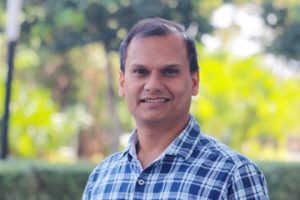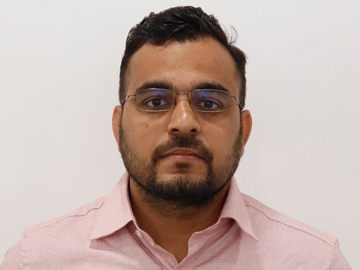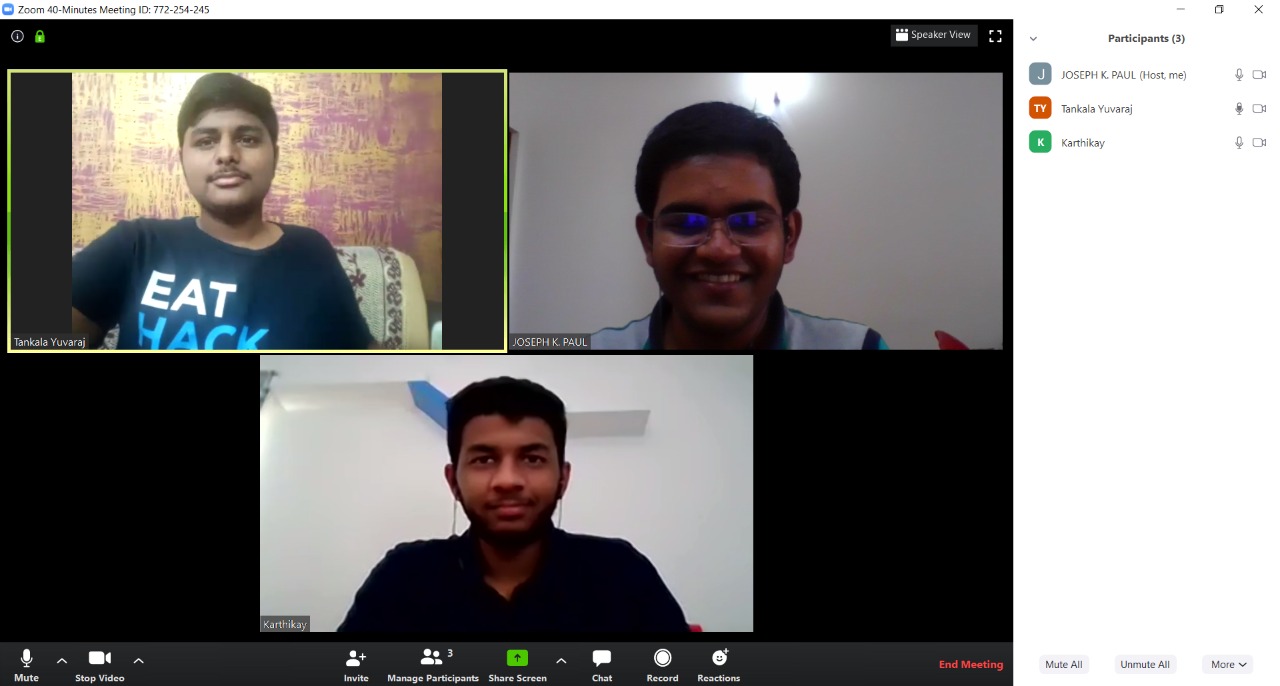- Small-World Wireless Sensor Network to Help Making Smart Applications for Industries April 26, 2020
 Dr Om Jee Pandey, Assistant Professor, Department of Electronics and Communication Engineering, has recently published two papers in renowned IEEE journals. His paper “Secrecy Performance Analysis of Two-way Relay Non-Orthogonal Multiple Access Systems” was published in IEEE Access Journal, having an impact factor: 4.06. Whereas, “Fault-Resilient Distributed Detection and Estimation over an SW-WSN Using LCMV Beamforming” was published in IEEE Transactions in Network and Service Management (Impact factor: 4.682). The study was done in associations with Prof. Rajesh M Hegde, Department of Electrical Engineering, IIT Kanpur and Prof. Ha H. Nguyen, Department of Electrical and Computer Engineering, University of Saskatchewan, Saskatoon, Canada. His research was focused on developing efficient Wireless Sensor Network services in small-world models. The proposed research can be applied in developing many state-of-the-art applications in the areas related to healthcare systems, climate-smart agriculture, intelligent transportation, home automation, manufacturing, smart utilities, and industries etc.
Dr Om Jee Pandey, Assistant Professor, Department of Electronics and Communication Engineering, has recently published two papers in renowned IEEE journals. His paper “Secrecy Performance Analysis of Two-way Relay Non-Orthogonal Multiple Access Systems” was published in IEEE Access Journal, having an impact factor: 4.06. Whereas, “Fault-Resilient Distributed Detection and Estimation over an SW-WSN Using LCMV Beamforming” was published in IEEE Transactions in Network and Service Management (Impact factor: 4.682). The study was done in associations with Prof. Rajesh M Hegde, Department of Electrical Engineering, IIT Kanpur and Prof. Ha H. Nguyen, Department of Electrical and Computer Engineering, University of Saskatchewan, Saskatoon, Canada. His research was focused on developing efficient Wireless Sensor Network services in small-world models. The proposed research can be applied in developing many state-of-the-art applications in the areas related to healthcare systems, climate-smart agriculture, intelligent transportation, home automation, manufacturing, smart utilities, and industries etc.In order to develop efficient Wireless Sensor Network (WSN) services, several methods have been proposed for node localization, clustering of sensor nodes, new routing algorithms, adaptive duty cycles, usage of mixed-transmission models, placement of intelligent gateways, usage of mobile elements, and bypassing holes. However, the introduction of small-world characteristics in a WSN has hitherto not been used in this context. A small-world network is typically characterized by a low average path length and high average clustering coefficient and has been widely used to model social networks. However, small world models have not been used in the development of WSN. The primary objective of this research is to develop small world models for WSN services such as sensor node localization, data gathering, data fusion, network lifetime maximization, energy-balancing, reduced data transmission delay, time synchronization, energy-harvesting, and robust distributed detection and estimation. A small world WSN reduces the number of hops required for data transmission, and maximal utilization of sensor nodes closer to the sink. Other advantages of small world WSN include efficient bandwidth utilization, increased network lifetime, and fast convergence of event detection and parameter estimation. Small world WSN developed in tandem with novel routing strategies leads to improved WSN services for various applications.
In WSNs, sensor devices transfer the data cooperatively using multiple hops over a network. Multiple hops required for data transmission over a WSN leads to reduced network performance in the context of device localization, energy efficiency, energy balancing, data latency, speed of event detection and parameter estimation, and network robustness. This is because of poor distance estimation between sensor device pairs, maximum utilization of sensor devices closer to the sink, and a short radio range of sensor devices. Hence, the primary focus of this research work is to reduce the number of hops required for data transmission. In this context, Small World Characteristics (SWC) can be introduced in a WSN, leading to a small world WSN (SW-WSN). An SW-WSN is a well-connected network with reduced hop counts between node pairs.
Small world phenomena were first observed by Stanely Milgram in social connectivity of people. Later, it came out as a theory of “six degrees of separation”. Six degrees of separation claims that all people are six, or fewer, social connections away from each other. This theory is also known as the 6 Handshakes rule. Further, small-world phenomena have been investigated in graphs. Subsequently, SWC is observed in wireless networks. In general, small world WSNs (SW-WSNs) are characterized by low Average Path Length (APL) and high Average Clustering Coefficient (ACC). For an undirected WSN with N nodes, representing a regular network, the APL increases linearly with the number of nodes present in the network. On the other hand, in a WSN having SWC the APL, between two randomly selected nodes grows proportionally to the logarithm of the number of nodes in the network. “WSNs are spatial graphs, where links are created using radio connectivity. There is a limit on the radio range of a sensor node, hence in such networks, the long-range connections are generally absent. Thus, these networks are clustered, but they do not experience small-world phenomena. Hence, the primary focus of this work is to develop SW-WSN using various methods leading to efficient WSN services” explained Dr Pandey.
Dr Pandey is now busy to take the studies further. His future projects include-
Continue reading →
• Small World WSN (or SW-WSN) Development for Smart Healthcare.
• Cognitive SW-WSN for Energy-Efficient CPS and IoT applications.
• Climate Smart Agriculture using Cognitive SW Characteristics.
• Low-Latency and Intelligent Transportation over small world CPS.
• Multi Sensor Fusion over SW-WSN for CPS/IoT Applications.
• Information and Context Quality in WSN, IoT and CPS Networks. - Dr. Sriramulu Bojjagani April 24, 2020
- Dr. Saleti Sumalatha April 24, 2020
- Paradigm shift to sustainable systems April 20, 2020
Dr. Lakhveer proposes to reduce the cost of bioreactors
 Reputed publishing house Elsevier has published the illuminating research work of Dr. Lakhveer Singh, Assistant Professor, Department of Environmental Science. The book named Bioreactors: Sustainable Design and Industrial Applications in Mitigation of GHG Emissions (1st Edition), is co-edited by Durga Mahapatra, Oregon State University, USA, Scientist and Dr Abu Yousuf, Assistant Professor, Shahjalal University of Science and Technology, Bangladesh.
Reputed publishing house Elsevier has published the illuminating research work of Dr. Lakhveer Singh, Assistant Professor, Department of Environmental Science. The book named Bioreactors: Sustainable Design and Industrial Applications in Mitigation of GHG Emissions (1st Edition), is co-edited by Durga Mahapatra, Oregon State University, USA, Scientist and Dr Abu Yousuf, Assistant Professor, Shahjalal University of Science and Technology, Bangladesh.Dawn of the 21st century has witnessed a solemn crisis in petroleum-derived fuels, consequently causing a major setback in chemicals/bio-products industries. Also, the researchers identify that the problem of climate change needs to be addressed by reducing the emission of greenhouse gases (GHGs). Dr. Lakhveer states, “To cope up with soaring energy demands, the present generation requires a paradigm shift from fossil-based resources to renewables and sustainable systems which accentuates the necessity of bioreactors for employing bioenergy and bio-products recovery”.
Presently, sophisticated bioreactor technologies have resulted in towering industrial production significantly contributing to the global economy and benefiting human life. Bioreactors have a substantial role in building a sustainable economy and providing food, feed, energy and other basic amenities for a quality life. Numerous bioreactors have evolved over time through sustainable research targeting commercialization.
A bioreactor is a vessel-like device that provides a uniform background for microorganisms to grow. It maintains an uninterrupted balance in the biochemical reactions carried out by these microorganisms to produce the desired metabolites. The applications of bioreactors extend to biomass production such as microalgae, single-cell protein, and yeast. For metabolite formation like organic acids, ethanol, antibiotics, aromatic compounds, and pigments, bioreactors are absolute. It also contributes to transforming substrates like steroids along with supplementing to production of both the intra and extracellular enzymes.
Recently, Dr Singh has developed an innovative cost-effective hybrid bioelectrochemical reactor (15.0 L) in collaboration with Oregon State University, USA, capable of generating efficient hydrogen at a cost less than $2/kg of H2 from lignocellulose hydrolysates or wastewater.
“In our research we have developed numerous types of bioreactors ranging in size from 5.0 to 100 L. A few examples are immobilized up-flow bioreactor, two-stage thermophilic and mesophilic fermenter, sequential dark and photobioreactor as well as hybrid bioelectrochemical reactor for bioenergy production and valuable products recovery from various industrial and agriculture waste. “ informs Dr. Lakhveer.
The book “Bioreactors” presents and compares the foundational concepts, state-of-the-art design and fabrication of bioreactors. Solidly based on theoretical fundamentals, it examines various aspects of the commercially available bioreactors, that includes construction, fabrication, design, modeling, simulation, development, operation, maintenance, management, and target applications for biofuels production as well as bio-waste management. Emerging issues in commercial feasibility are explored in the book along with covering the constraints and pathways for upscaling. It also carries out rigorous techno-economic assessment.
“This book provides researchers and engineers in the biofuels and waste management sectors a clear understanding of the actual potential of various advanced bioreactors for their requirements. It allows them to embark on informed decisions while selecting the appropriate technology models for sustainable systems development and commercialization”, says Dr. Lakhveer.
Advancing his work, Dr Singh is developing efficient and economical bioreactors for commercial applications in the energy and water sectors. In this regard, three international patents have been filed. In the next few months, two more of his books are to be published by American Chemical Society, ACS and Elsevier. The books will emphasize issues and frontiers of reactors technology such as operation, novel design, cost analysis, novel electrodes, nano catalytic materials and other extended applications of bioreactors.
Continue reading → - Young minds excelled at national level Hackathon April 5, 2020
Amidst the quarantine, students of SRM AP and members of NEXT TECH LAB, have exhibited their expertise in HACKNITR, a national level hackathon organized by NIT Rourkela on 21-22 March 2020. The outstanding merit of their project has enabled them to bag the Runner-Up and 2nd Runner-Up position at the hackathon.
 Team ASTUTE BOTS consulting
Team ASTUTE BOTS consulting
Team ASTUTE BOTS, comprising of 1st-year students, Tankala Yuvaraj, Karthikay Gundepudi and Joseph K. Paul, was recognized as the Runner-Up. They used the AI-IoT platform to develop DRONEYES; a prototyped solution that can be used to reduce poaching. It is an aerial reconnoiter which flies in stealth mode and takes the video or photo of a suspected poacher. This is done by the highly trained object detection model called YOLOv3. These eyes not only detect objects on the terra firma but also sends the exact location via GPS. “With the help of cloud technology, we can share the data in real-time so that the user/organization can take the required initiative by locating the exact place of poaching”, explains Karthikay. We were inspired to attend hackathons by Anshuman Pandey, and Next Tech Lab supported this achievement.
Another team PUSH, where Karthik Epperla, 2nd year, and Ishita Agarwal, 1st year, participated, has received the 2nd Runner’s up award. The students worked on an AI-VR-Blockchain based application to help people with autism improve communication, social and other basic abilities required to live in a society. It gives a set of YES/NO questions that are to be answered by either the parent of the child or the adult suffering from Autism and then it matches those answers with the dataset which then returns the level of autism that the child/adult is suffering from. Depending on the level, the user can choose the extremity of VR therapy. When the child goes through the VR session, the parent can view what their child/ adult is doing in the virtual environment using the parent app from anywhere and advise their ward offering extra support to the patient. ” Our application has 3D simulations of real-life situations wherein autistic children/ adults (mostly children) can practice and understand how to behave/react in those situations and overcome their fear while facing a similar situation in real life. “, adds Karthik.
Karthik acknowledges Adithya Ramakrishnan the founder of Next Tech Lab and his lab mate, Lakshmi Vallala for implanting the noble idea that AI can help in the rare medical condition, Autism. They have constantly been in touch with a few special schools and treatment centers to know about the behaviour and nature of autistic people so that they can keep on building different versions of applications.
In the natal stage of their academic career, the students are guided and nurtured in an environment by the Next Tech Lab and the faculty members which inspires them to positively impact the society. The ample exposure offered to the students will not merely encourage them, but also enable them to improve their concepts.
Continue reading →

